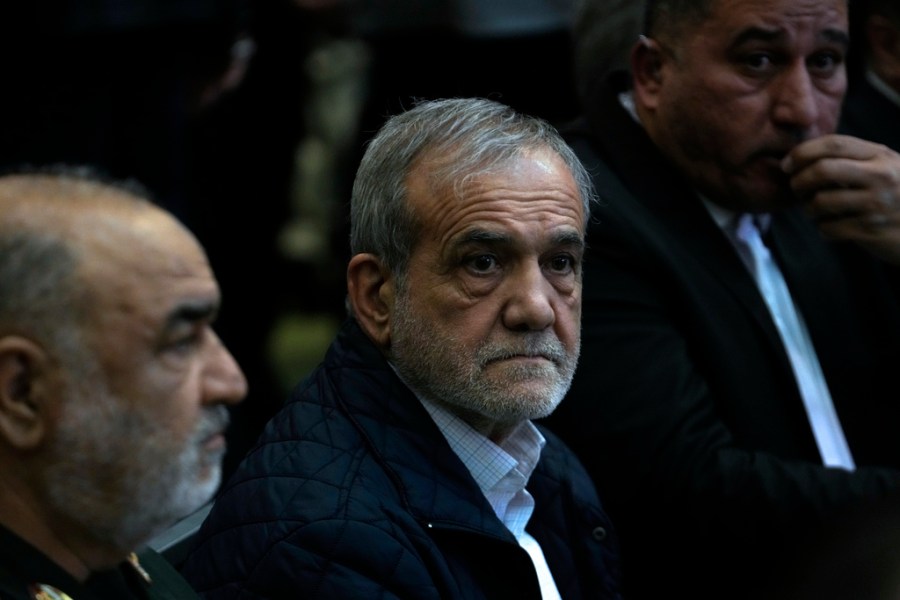The incoming Trump administration has expressed support for a negotiated solution with Iran on all outstanding issues. When asked about a message to Iranian Supreme Leader Ali Khamenei, President-elect Trump simply said, “I wish him luck.”
During his 2024 presidential campaign, Trump indicated that his Iran policy in the second term would be “very different” than that in his first. He rejected the “regime change” policy and reiterated that he wants Iran to be successful, but also that he opposes the country’s acquisition of nuclear weapons.
In September 2024, Iranian President Masoud Pezeshkian stated that Tehran is ready for “constructive” dialogue and is “ready to engage” with the West about nuclear power, and willingness to improve relations with the U.S.
Nevertheless, the gaps between Washington and Tehran will be difficult to bridge. If Trump wishes to break the deadlock by negotiating with Iran, he will face fierce opposition within the U.S., in Iran, and in the region. Last month, Israel’s former war Cabinet member, Benny Gantz, called for Iran to be targeted “directly.”
Assuming Trump wants an alternative to another endless conflict, the first step must be a new nuclear agreement with Iran. It is likely that Israel will want the dismantlement of Iran’s enrichment capabilities. When I was the spokesperson for Iran’s nuclear team (2003-05), however, in a private meeting, Ayatollah Khamenei told Rouhani — then Iran’s top nuclear negotiator — that “if Iran is to abandon its right to enrich, it will either have to happen after my death, or I will have to resign from leadership.” Forcing this option would therefore likely mean the failure of negotiations, just as they failed from 2003-13.
If Trump’s main objective is to ensure that Iran does not acquire a nuclear bomb, however, he needs a plan that would permanently block the acquisition of nuclear bombs not only by Iran but also by other ambitious countries in the region. As President Biden warned, “if Iran gets the bomb, then Saudi Arabia, Turkey, and Egypt will follow.”
Here are the elements of such a plan:
First, as in the Obama administration’s Iran nuclear deal, Iran would agree to complete transparency of its nuclear programs and the most stringent level of International Atomic Energy Agency verification measures.
Second, the key principles of the agreement would be that it applies to all the countries in the region, making it possible to make permanent the main nonproliferation limitations of the deal, including limiting uranium enrichment to below 5 percent and no separation of plutonium from spent fuel.
Third, following the implementation of a new nuclear deal, Washington and Tehran would need to engage in discussions about regional security. Both countries should temporarily suspend all threats and hostilities as a first step and goodwill gesture.
Some years ago, Robert Einhorn, then a U.S. nuclear negotiator told me that “when we raise the necessity of regional talks, some Iranians mistakenly believe that we mean the dismantling of Iran’s missile and defense capabilities. All countries including Iran have the right to the defense capabilities they need. We understand that Iran, like us, has its own security concerns. Both sides must therefore engage in a serious and fair dialogue to address each other’s legitimate and lawful concerns and find a balanced solution.”
Ayatollah Khamenei is the ultimate decision-maker regarding Iran’s relations with the United States. On Jan. 8, 2024, he said that the U.S. is fundamentally hostile to the Iranian nation and the Islamic Republic, wishing for the destruction of Iran. Based on the several decades of understanding I have of his views, I believe that the essence of his concerns regarding the relations with the U.S. can be summarized in three key points: the threat to Iran’s independence through interference in internal affairs, the “regime change” policy and the lack of respect for and recognition of Iran’s national interests.
On the other side, during 15 years of research at Princeton University on U.S.-Iran relations, I believe that “challenging and threatening the U.S. interests in the region” is the most important concern the U.S. has regarding Iran’s policies after the 1979 revolution.
If there is going to be a fair and balanced deal, both capitals should acknowledge each other’s legitimate regional interests and commit to not threatening those interests. This would require some realignment of their regional security and diplomacy strategies, especially with their key allies.
Moreover, it would require a credible and sustainable model for regional stability and peace. Iran, Iraq, Saudi Arabia and other Gulf Cooperation Council countries in the Persian Gulf, could achieve such an arrangement through a new collective security and economic framework modeled on the Organization for Security and Cooperation in Europe.
The arrangement would facilitate establishing balanced and normal relations with the Western and Eastern blocs; regional arms control arrangements including a nuclear weapons-free zone and the reduction of U.S. military forces and expenditures in the region.
The agreement could also link a cessation of military conflict between Iran and Israel with a just and durable solution to the Palestinian-Israeli conflict based on a two-state solution as required by multiple UN resolutions.
Finally, the deal could also include significant economic cooperation between the U.S. and Iran, potentially involving projects worth hundreds of billions of dollars in sectors such as petrochemicals, aviation and clean energy. This would create major economic stakes in the agreement within both countries, making the new arrangements more robust.
On his first day in office at the White House, President Trump could agree in a phone conversation with his Iranian counterpart, President Pezeshkian, to have special envoys from both countries quickly initiate direct talks for such a fair, sustainable and historic agreement.
Seyed Hossein Mousavian is Middle East security and nuclear policy specialist at Princeton University.

